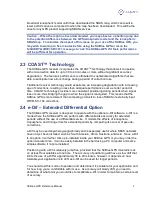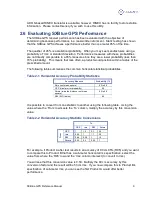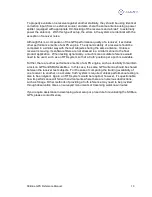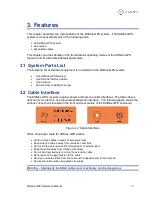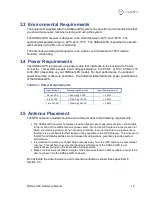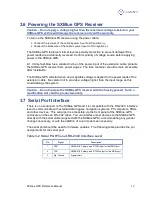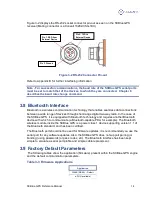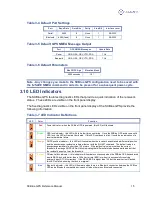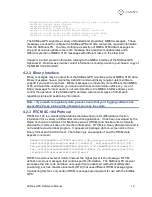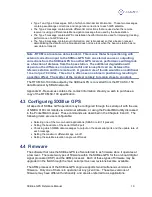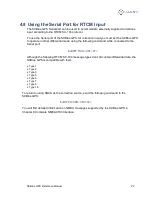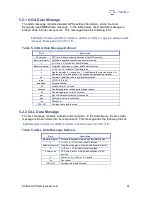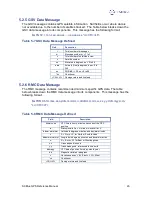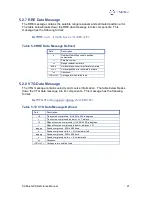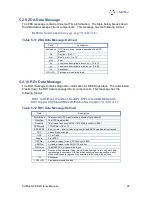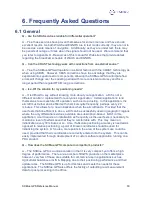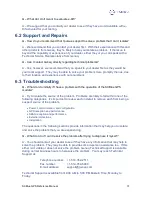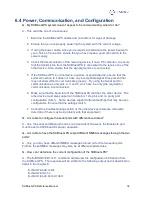
SXBlue GPS Reference Manual
18
$GPGGA,141823.00,4536.79732,N,07333.95861,W,2,09,1.0,49.6,M,-32.4,M,5.4,0313*4E
$GPVTG,151.61,T,,M,0.08,N,0.15,K,D*36
$GPZDA,141823.00,9,7,2004,00,00*63
$GPGSA,M,3,06,08,10,17,18,21,24,26,29,,,,1.7,1.0,1.3*31
$GPGSV,3,1,11,06,40,234,48,08,18,056,42,10,43,066,45,16,00,319,*7F
$GPGSV,3,2,11,17,43,121,45,18,21,264,45,21,39,304,45,24,10,125,45*7E
$GPGSV,3,3,11,26,69,160,48,27,07,031,39,29,73,109,45,,,,*45
The SXBlue GPS supports a variety of standard and proprietary NMEA messages. These
messages are used to configure the SXBlue GPS and also contain the required information
from the SXBlue GPS. You may configure a selection of NMEA 0183 data messages on
one port at various update rates (each message has a maximum update rate) and a
different selection of NMEA 0183 messages with different rates on the other port.
Chapters 8 and 9 present information relating to the NMEA interface of the SXBlue GPS.
Appendix D - Resources provides contact information should you wish to purchase a copy of
the NMEA 0183 standard.
4.2.2 Binary Interface
Binary messages may be output from the SXBlue GPS simultaneously as NMEA 0183 data.
Binary messages have a proprietary definition and would likely require custom software
support if you wish to use them. Binary messages are inherently more efficient than NMEA
0183 and would be used when you require maximum communication efficiency. Use of
binary messages for most users is not recommended - the NMEA interface allows you to
control the operation of the SXBlue GPS and also receive most types of information
regarding status and positioning information.
Note – If you wish to log binary data, please ensure that your logging software has
opened the file as a binary file, otherwise you may lose data.
4.2.3 RTCM SC-104 Protocol
RTCM SC-104 is a standard that defines the data structure for differential correction
information for a variety of differential correction applications. It has been developed by the
Radio Technical Commission for Maritime services (RTCM) and has become an industry
standard for communication of correction information. RTCM is a binary data protocol and is
not readable via a terminal program. It appears as ‘garbage’ data on-screen since it is a
binary format and not ASCII text. The following is an example of how the RTCM data
appears on-screen:
mRMP@PJfeUtNsmMFM{nVtIOTDbA^xGh~kDH`_FdW_yqLRryrDuhcB\@}N`ozbSD@O^}nr
GqkeTlpLLrYpDqAsrLRrQN{zW|uW@H`z]~aGxWYt@I`_FxW_qqLRryrDCikA\@Cj]DE]|
E@w_mlroMNjkKOsmMFM{PWDwW@HVEbA^xGhLJQH`_F`W_aNsmMFM[WVLA\@S}amz@ilIu
Pqx~_IZhTCpLLrYpdP@kOsmMFM[kVDHwVGbA^P{WWuNt_SW_yMsmMnqdrhcC\@sE^ZfC@
}vJmNGAHJVhTCqLRryrdviStW@H_GbA^P{wxu[K
RTCM has various levels of detail; however the highest level is the message. RTCM
defines numerous messages that contain specific information. The SXBlue GPS receiver
processes the C/A code and does not support more advanced methods of differential
positioning, such as real-time kinematic (RTK) that uses different RTCM message types.
Considering this fact, only certain RTCM messages are important for use with the SXBlue
GPS:




